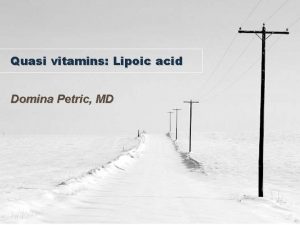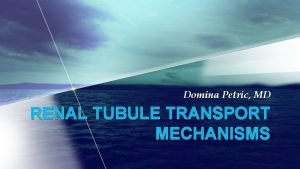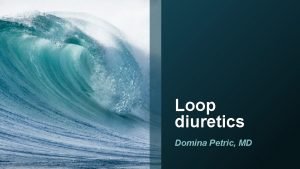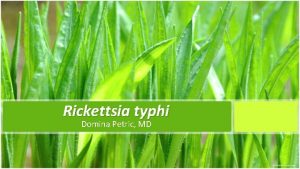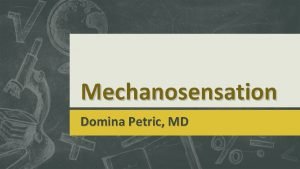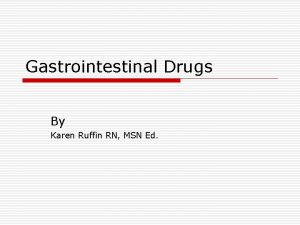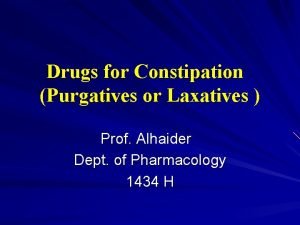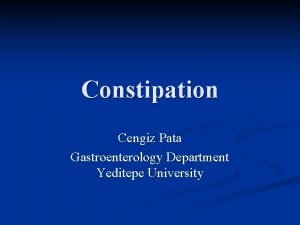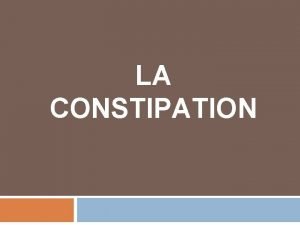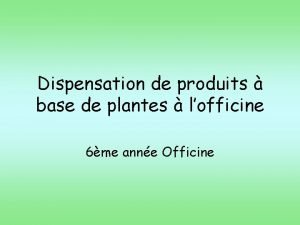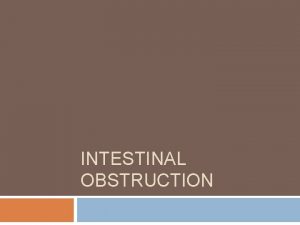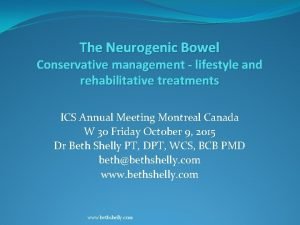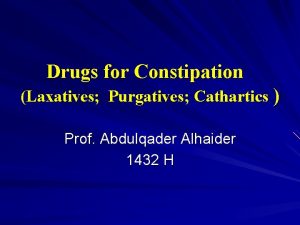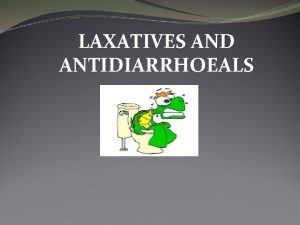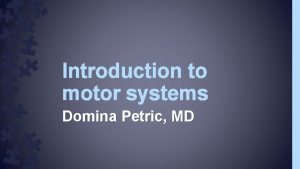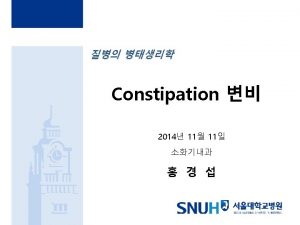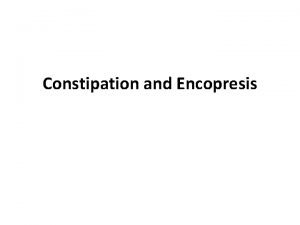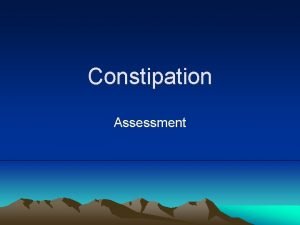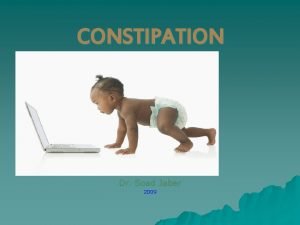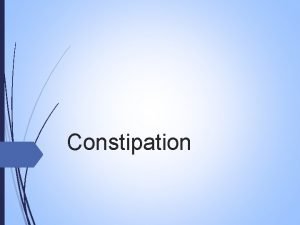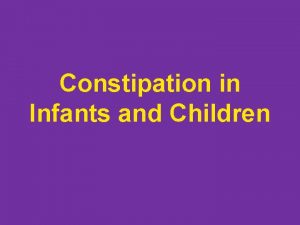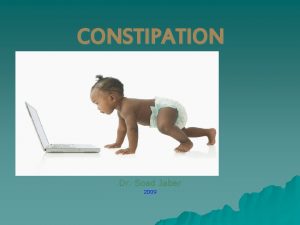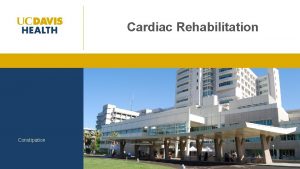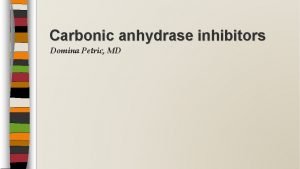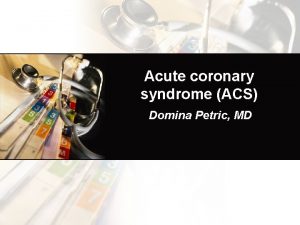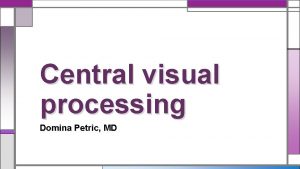Laxatives Domina Petric MD Introduction Intermittent constipation is




















- Slides: 20

Laxatives Domina Petric, MD

Introduction Intermittent constipation is best prevented with a high-fiber diet, adequate fluid intake, regular exercise and the heeding of nature´s call. Patients not responding to dietary changes or fiber supplements should undergo medical evaluation before initiating long-term laxative treatment.

Bulk-forming laxatives • Indigestible, hydrophilic colloids that absorb water, forming a bulky, emollient gel that distends the colon and promotes peristalsis. • Natural plant products: psyllium, methylcellulose. • Synthetic fibers: polycarbophil. • Bacterial digestion of plant fibers within the colon may lead to increased bloating and flatus.

Stool surfactant agents (softeners) • These agents soften stool material, permitting water and lipids to penetrate. • They may be administered orally or rectally. • Examples: docusate (oral, enema), glycerin suppository. • Docusate is used in hospitalized patients to prevent constipation and minimize straining. • Mineral oil is a clear, viscous oil that lubricates fecal material, retarding water absorption from the stool. • It is used to prevent and treat fecal impaction in young children and debilitated adults. • Long-term use can impair absorption of fat-soluble vitamins (K, A, D, E).

Osmotic laxatives • The colon can neither concentrate nor dilute fecal fluid. • Fecal water is isotonic throughout the colon. • Osmotic laxatives are soluble, but nonabsorbable compounds that result in increased stool liquidity due to an obligate increase in fecal fluid. Osmotic laxatives are: • NONABSORBABLE SUGARS OR SALTS • BALANCED POLYETHYLENE GLYCOL

Nonabsorbable sugars or salts • These agents may be used for the treatment of acute constipation or the prevention of chronic constipation. • Magnesium hydroxide (milk of magnesia) is a commonly used osmotic laxative. • It should not be used for prolonged periods in pateints with renal insufficiency due to the risk of hypermagnesemia. • Sorbitol and lactulose are nonabsorbable sugars that can be used to prevent or treat chronic constipation. • These sugars are metabolized by colonic bacteria, producing severe flatus and cramps.

Nonabsorbable sugars or salts • High doses of osmotically active agents produce prompt bowel evacuation (purgation) within 1 -3 hours. • The rapid movement of water into the distal small bowel and colon leads to a high volume of liquid stool followed by rapid relief of constipation. • Magnesium cistrate, sodium phosphate: it is very important that patients maintain adequate hydration by taking increased oral liquids to compensate for fecal fluid loss. • Sodium phosphate frequently causes hyperphosphatemia, hypocalcemia, hypernatremia and hypokalemia, which can lead to cardiac arrhythmias or acute renal failure.

Nonabsorbable sugars or salts • Acute renal failure may happen due to tubular deposition of calcium phosphate (nephrocalcinosis). Sodium phosphate preparations should not be used in patients who: • are frail or elderly • have renal insufficiency • have significant cardiac disease • are unable to maintain adequate hydration during bowel preparation

Balanced polyethylene glycol (PEG) • Large solutions containing PEG are used for complete colonic cleansing before gastrointestinal endoscopic procedures. • These balanced, isotonic solutions contain an inert, nonabsorbable, osmotically active sugar (PEG) with sodium sulfate, sodium chloride, sodium bicarbonate and potassium chloride. • PEG is safe: no significant intravascular fluid or electrolyte shifts occur and does not produce significant cramps or flatus. • Bowel cleansing: 2 -4 L over 2 -4 hours. • Treatment or prevention of chronic constipation: 17 g/8 oz (powder mixed with water or juices, daily use).

Stimulant laxatives • Also called cathartics. • Induce bowel movements through a direct stimulation of the enteric nervous system and colonic electrolyte and fluid secretion. Cathartics are: • ANTHRAQUINONE DERIVATIVES • DIPHENYLMETHANE DERIVATIVES

Anthraquinone derivatives • Aloe, senna and cascara: poorly absorbed, after hydrolysis in the colon, produce a bowel movement in 6 -12 hours when given orally and within 2 hours when given rectally. • Chronic use leads to a characteristic brown pigmentation of the colon: MELANOSIS COLI. Laendo. ne t

Diphenylmethane derivatives • Bisacodyl is available in tablet and suppository formulations for the treatment of acute and chronic constipation. • It is also used in conjunction with PEG solutions for colonic cleansing prior to colonoscopy. • It induces a bowel movement within 6 -10 hours when given orally and 30 -60 minutes when taken rectally. • It has minimal systemic absorption and it is safe for acute and long-term use.

Chloride channel activator • Lubiprostone is a prostanoic acid derivative labeled for use in chronic constipation and irritable bowel syndrome (IBS) with predominant constipation. • It acts by stimulating the type 2 chloride channel (Cl. C -2) in the small intestine. • This increases chloride-rich fluid secretion into the intestine, which stimulates intestinal motility and shortens intestinal transit time. • Lubiprostone has minimal systemic absorption, but it is not recommended for pregnant women (category C). • It may cause nausea (30%) due to delayed gastric emptying.

Opioid receptor antagonists • Acute and chronic opioids therapy may cause constipation by decreasing intestinal motility, which results in prolonged transit time and increased absorption of fecal water. • Use of opioids after surgery (pain treatment) and endogenous opioids released after surgery may prolong the duration of postoperative ileus: intestinal μ-opioid receptors. • Selective antagonists of the μ-opioid receptors are: METHYLNALTREXONE and ALVIMOPAN. • These agents do not readily cross the blood-brain barrier and inhibit peripheral μ-opioid receptors without impacting analgesic effects within the CNS.

Opioid receptor antagonists • Methylnaltrexone is approved for the treatment of opioid-induced constipation in patients receiving palliative care for advanced illness who have had inadequate response to other agents. • It is administered as a subcutaneous injection 0, 15 mg/kg every 2 days. • Alvimopan is approved for short-term use to shorten the period of postoperative ileus in hospitalized patients who have undergone small or large bowel resection. • It is administered orally 12 mg capsule 5 hours before surgery and twice daily after surgery (no more than 7 days).

Serotonin 5 -HT 4 receptor agonists • Stimulation of 5 -HT 4 receptors on the presynaptic terminal of submucosal intrinsic primary afferent nerves enhances the release of neurotransmitters, including calcitonin generelated peptide (CGRP). • CGRP stimulates second-order enteric neurons to promote the peristaltic reflex. • These enteric neurons stimulate proximal bowel contraction (acetylcholine, substance P) and distal bowel relaxation (nitric oxide, vasoactive intestinal peptide). • Agents are tegaserod, cisapride and prucalopride.

Serotonin 5 -HT 4 receptor agonists Tegaserod is serotonin 5 -HT 4 partial agonist that has high affinity for 5 -HT 4 receptors, but no appreciable binding to 5 -HT 3 or dopamine receptors. It was approved for the patients with chronic constipation and IBS with predominant constipation. Both tegaserod (removed from general market) and cisapride can cause serious cardiovascular events.

Serotonin 5 -HT 4 receptor agonists Prucalopride is high-affinity 5 -HT 4 agonist available for the treatment of chronic constipation in women. It does not have significant affinities for h. ERG channels and 5 -HT 1 B receptors (in constrast to tegaserod and cisaprid).

Guanylate cyclase C agonists Linaclotide is a poorly absorbed 14 amino-acid peptide that binds to the guanylate cyclase C receptor on the luminal surface of intestinal enterocytes. It activates the cystic fibrosis transmembrane conductance channels and stimulates intestinal fluid secretion.

Literature • Katzung, Masters, Trevor. Basic and clinical pharmacology. • Laendo. net
 Quasi vitamins
Quasi vitamins Domina petric
Domina petric Domina petric
Domina petric Domina petric
Domina petric Domina petric
Domina petric Pseudomonopolar
Pseudomonopolar Domina tasks
Domina tasks Laxative agent
Laxative agent Magnesium side effects
Magnesium side effects Laxatives side effects
Laxatives side effects Types of laxatives
Types of laxatives Ashraf radwan
Ashraf radwan Rectum
Rectum Vibtil remplacement
Vibtil remplacement Dr esraa al-sammak
Dr esraa al-sammak Claw sign intussusception
Claw sign intussusception How much does arimidex increase survival
How much does arimidex increase survival Dr quet
Dr quet Constipation
Constipation Massage for constipation
Massage for constipation Aliment riche en fibre constipation
Aliment riche en fibre constipation
